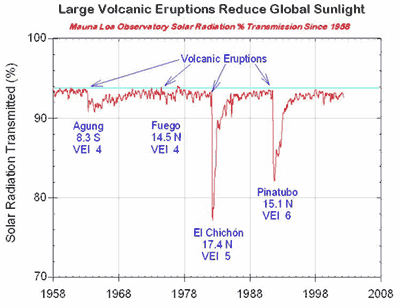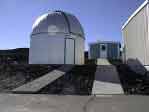More than two years after road access and electrical power to the Mauna Loa Observatory was cut off by lava flows, NOAA staff continue to make critical measurements of the atmosphere and other environmental variables at the remote site.
In 2023, observatory staff installed solar panels at the site and resumed some measurements, including the independent carbon dioxide monitoring programs run by the Global Monitoring Laboratory and Scripps Institution of Oceanography, as well as other atmospheric measurements.
Construction of a temporary road to access the observatory site is anticipated to begin in summer 2025.
Media can contact: Theo Stein (303) 819-7409 (theo.stein@noaa.gov)
Organization(s):
 National Oceanic and
Atmospheric Administration (NOAA), Earth System Research Laboratory (ESRL)
National Oceanic and
Atmospheric Administration (NOAA), Earth System Research Laboratory (ESRL)
What does this program measure?
Total Downwelling solar and thermal infrared radiation (or irradiance) is measured in units of Watts per square meter. Aaerosol optical depth is also measured.
*** The Mauna Loa Observatory record of solar transmission of sunlight is the longest continuous record of this nature in existence.
How does this program work?
We primarily use commercial thermopile broadband radiometers to measure the irradiance and aerosol optical depth, a measure of the total dust and particle load of the atmosphere, is measured with a sunphotometer.
| Measurement | Instruments | Frequency | Site |
|---|---|---|---|
| Global Irradiance | Eppley Pyranometers with Q, OG1, and RG8 filters | continuous | MLO |
| Direct Irradiance | Eppley pyrheliometer with Q filter(2) | continuous | MLO |
| Direct Irradiance | Eppley pyrheliometer with Q, OG1, RG2, and RG8 filters | 3/day (weekdays) |
MLO |
| Direct Irradiance | Eppley/Kendall active cavity radiometer | continuous | MLO |
| Diffuse Irradiance | Eppley pyrgeometer with shading disk and Q filter (2) | continuous | MLO |
| UV Solar Radiation | Yankee Environmental UVB pyranometer (230-320 nm) | continuous | MLO |
| Diffuse (IR) Irradiance | Terrestrial downwelling IR pyrgeometer with shading disk | continuous | MLO |
| Column Water Vapor | 2 two-wavelength tracking sunphotometers: 860, 940 nm | continuous | MLO |
Why is this research important?
Solar and infrared radiation are fundamental ingredients in maintaining the current climate, and also play a major role in anticipated changes in that climate. Aerosol optical depth helps quantify the role of aerosol in radiatively forced climate change.
Are there any trends in the data?
Read a MLO Solar Irradiance publication (.pdf format)
While no persistent long-term trends have been detected, there are excursions of several years in duration following major volcanic eruptions and there appears to be increased springtime aerosol loading in the last few years.
As the plot below shows, aerosols from large volcanic eruptions block some sunlight from reaching the earth's surface. Note how the lidar measurements of the volcanic aerosols in the stratosphere anti-correlate with the solar record.

How does this program fit into the big picture?
What is it's role in global climate change?
Solar and thermal infrared (IR) radiation are vehicles for climate change but at the same time are affected by that change. Our radiation measurements can be used to investigate both the causes of and the response to climate change.
Comments and References
- Dutton, E. G., J. J. DeLuisi, and A. P. Austring, 1985. Interpretation of Mauna Loa
- Atmospheric Transmission Relative to Aerosols, Using Photometric Precipitable Water Amounts. J. Atmos. Chem., 3, 53-68.
- Dutton, E.G., 1992. A Coherence Between the QBO and the Amplitude of the Mauna Loa Atmospheric Transmission Annual Cycle. International J. Climatology 12, 383-396.
- Dutton, E.G. and J.R. Christy, 1992. Solar Radiative Forcing at Selected Locations and Evidence for Global Lower Tropospheric Cooling Following the Eruptions of El Chichón and Pinatubo. Geophys. Res. Lett. 19, 2313-2316.
- Dutton, E.G., P. Reddy, S. Ryan, and J.J. DeLuisi, 1994. Features and effects of optical depth observed at Mauna Loa, Hawaii: 1982-1992. J. Geophys. Res. 99, 8295-8306.
- Dutton, E.G. and B.A. Bodhaine, 2001: Solar irradiance anomalies caused by clear-sky transmission variations above Mauna Loa 1957-1999. J. Clim., 14, 3255-3262.
Lead Investigator(s):
Dr. Ellsworth
Dutton
303-497-6660
Jim Wendell
303-497-6994
MLO Contact(s):
Paul Fukumura
808-933-6965 (x223)
Web Site(s)
Date Started
1956

